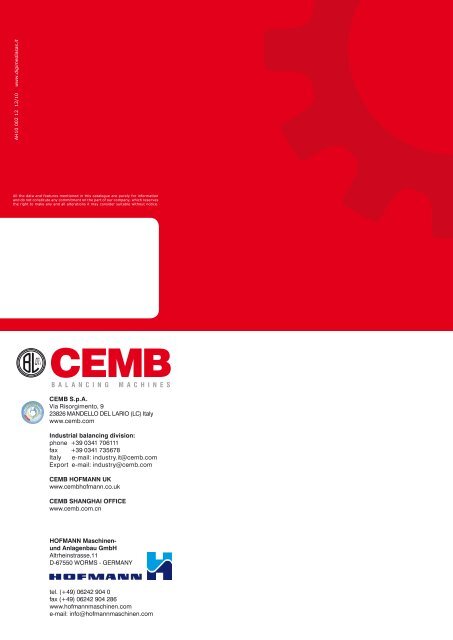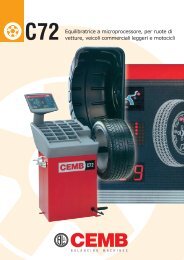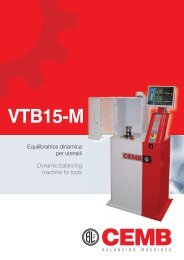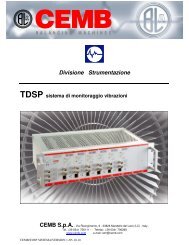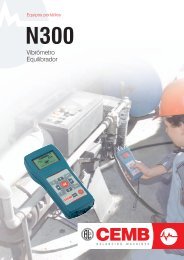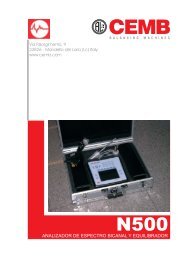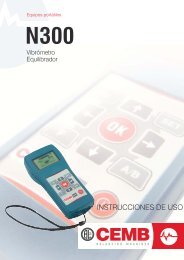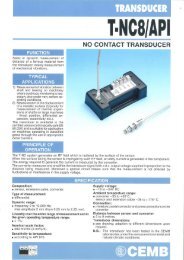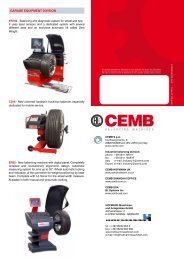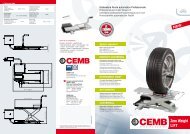Catalogo equilibratrici asse orizzontale - Cemb S.p.A.
Catalogo equilibratrici asse orizzontale - Cemb S.p.A.
Catalogo equilibratrici asse orizzontale - Cemb S.p.A.
You also want an ePaper? Increase the reach of your titles
YUMPU automatically turns print PDFs into web optimized ePapers that Google loves.
AH10 002 12 12/10 www.digimediasas.it<br />
All the data and features mentioned in this catalogue are purely for information<br />
and do not constitute any commitment on the part of our company, which reserves<br />
the right to make any and all alterations it may consider suitable without notice.<br />
B A L A N C I N G M A C H I N E S<br />
CEMB S.p.A.<br />
Via Risorgimento, 9<br />
23826 MANDELLO DEL LARIO (LC) Italy<br />
www.cemb.com<br />
Industrial balancing division:<br />
phone +39 0341 706111<br />
fax +39 0341 735678<br />
Italy e-mail: industry.it@cemb.com<br />
Export e-mail: industry@cemb.com<br />
CEMB HOFMANN UK<br />
www.cembhofmann.co.uk<br />
CEMB SHANGHAI OFFICE<br />
www.cemb.com.cn<br />
HOFMANN Maschinenund<br />
Anlagenbau GmbH<br />
Altrheinstr<strong>asse</strong>,11<br />
D-67550 WORMS - GERMANY<br />
tel. (+49) 06242 904 0<br />
fax (+49) 06242 904 286<br />
www.hofmannmaschinen.com<br />
e-mail: info@hofmannmaschinen.com
Z<br />
EQUILIBRATRICI<br />
ORIZZONTALI<br />
A MISURA DI FORZA<br />
HORIZONTAL<br />
HARD-BEARING<br />
BALANCING MACHINES<br />
B A L A N C I N G M A C H I N E S
CEMB S.p.A. e HOFMANN Maschinen- und Anlagenbau GmbH di Worms - Germania<br />
costituiscono un importante polo in grado di fornire prodotti innovativi e concorrenziali<br />
integrati in un unica filosofia tecnica e costruttiva. Particolare attenzione è dedicata al<br />
servizio tecnico di assistenza post vendita in modo di garantire la completa soddisfazione<br />
del cliente. Grazie a questo sodalizio si ha un ampio range di produzione:<br />
• macchine <strong>equilibratrici</strong> universali orizzontali e verticali per applicazioni industriali<br />
• sistemi automatici di equilibratura per:<br />
- pneumatici e ruote complete<br />
- volani, giranti di pompe, dischi freno e tamburi freno<br />
- motori elettrici<br />
- alberi a gomito ed alberi di trasmissione<br />
- elettroventilatori<br />
- <strong>equilibratrici</strong> statiche gravitazionali<br />
- macchine di prova pneumatici<br />
- macchine per prova in serie delle uniformità di pneumatici e ruote complete<br />
- linee automatiche di montaggio, inserzione valvola, gonfiaggio, equilibratura di ruote<br />
• apparecchiature portatili per la misurazione, l’analisi ed l’equilibratura in condizione<br />
di servizio<br />
• strumentazioni fisse per il monitoraggio ed il controllo della vibrazione di<br />
macchinari<br />
• attrezzature per garage:<br />
- <strong>equilibratrici</strong> per ruote<br />
- linee diagnostiche per la prova di freni e sospensioni<br />
- allineamento ruote<br />
- smontagomme<br />
CEMB S.p.A. and HOFMANN Maschinen- und Anlagenbau GmbH of Worms in Germany,<br />
are an important industrial group suppling innovative products at competitive prices, all<br />
integrated in a single technical and construction philosophy. In particular, special care is<br />
dedicated to after-sales service, in order to ensure complete customer satisfaction.<br />
Thanks to this association the following wide range of products are offered:<br />
• universal horizontal and vertical balancing machines for industrial applications<br />
• automatic balancing systems for:<br />
- complete tyres and <strong>asse</strong>mbled wheels<br />
- flywheels, brake discs and brake drums<br />
- electric motors<br />
- crankshafts and transmission shafts<br />
- motor-fans<br />
- static gravitational balancing machines<br />
- tyre testing machines<br />
- machines for uniformity testing of complete wheel and tyre <strong>asse</strong>mblies<br />
- automatic lines for tyre and wheel fitting, valve inserting, tyre inflating and complete<br />
wheel <strong>asse</strong>mbly balancing<br />
• portable equipment for measuring, analysing and balancing in service conditions<br />
• fixed instrumentation for monitoring and controlling machinery<br />
• equipment for garages:<br />
- wheel balancing machines<br />
- diagnostic lines for brake and suspension testing<br />
- wheel alignment<br />
- tyre changers
Z Equilibratrici<br />
orizzontali a misura di forza<br />
Horizontal hard-bearing balancing machines<br />
Tutte le macchine della serie Z sono a supporti<br />
rigidi. La caratteristica fondamentale è che la forza<br />
centrifuga generata dallo squilibrio non provoca<br />
vibrazioni della struttura portante il rotante ma,<br />
attraverso il trasduttore di forza, si scarica totalmente<br />
sulla incastellatura dei supporti, avente elevata<br />
rigidità. Il segnale che si ottiene è proporzionale alla<br />
forza centrifuga prodotta dallo squilibrio.<br />
Dal fatto che la forza centrifuga di squilibrio è<br />
indipendente dalla massa del rotante, dalla sua<br />
inerzia e dalla sua forma, deriva il fondamentale<br />
pregio delle <strong>equilibratrici</strong> rigide che consiste<br />
nella possibilità della immediata taratura in base<br />
solamente alle dimensioni del rotante. Infatti scelti i<br />
piani di correzione, basta impostare sulla macchina<br />
le distanze di detti piani dai rispettivi supporti, la<br />
distanza fra tali piani e i raggi di correzione.<br />
Questa impostazione, da farsi a macchina ferma,<br />
permette un’ottima taratura senza lanci di prova e<br />
senza calcoli. Poiché l’elasticità della fondazione<br />
riduce la rigidità complessiva, l’equilibratrice rigida<br />
richiede un buon fissaggio al suolo.<br />
Non è però richiesta per i casi usuali una apposita<br />
fondazione ma è sufficiente un normale pavimento<br />
d’officina con una buona superficie e una robusta<br />
soletta. I supporti delle <strong>equilibratrici</strong> rigide sono<br />
All the machines in the Z series have hard bearings.<br />
The basic characteristic is that the centrifugal force<br />
generated by the unbalance does not cause vibrations<br />
in the structure bearing the rotor, but is unloaded<br />
completely via the force transducer onto the frame<br />
construction of the pedestals, which are very hard.<br />
The signal obtained is proportional to the centrifugal<br />
force produced by the unbalance. The fact that the<br />
centrifugal unbalance force is independent from<br />
rotor mass, of its inertia and shape is from the basic<br />
advantage of hard-bearing balancing machines,<br />
which consists in the possibility to calibrate its settings<br />
immediately considering only the rotor dimensions. In<br />
fact, once you have chosen the correction planes, all<br />
you have to set on the machine are distances of these<br />
planes from their respective pedestals, the distances<br />
between the planes and the correction diameters.<br />
These settings, which are made with the machine at<br />
a standstill, produce excellent calibration without any<br />
test spins or calculations. A hard bearing machine has<br />
to be fixed firmly to the ground, because incoming<br />
vibration may affect the balancing result.<br />
However, for all normal purposes a special foundation<br />
is not required; all you need is a normal workshop<br />
concrete floor with a good surface. The pedestals<br />
of hard-bearing balancing machines are practically<br />
praticamente isotropi, ossia hanno uguale rigidità<br />
in tutte le direzioni, così che sono particolarmente<br />
idonei per l’equilibratura dei rotanti flessibili. Le<br />
<strong>equilibratrici</strong> Z hanno tutte un trasduttore di forza di<br />
tipo piezoelettrico.<br />
Questa soluzione è la moderna evoluzione del<br />
sistema a supporti semi-rigidi, ove il trasduttore di<br />
forza era costituito da una lamina con un sensore<br />
elettrodinamico. Tale soluzione, usata ancora da<br />
qualche costruttore di <strong>equilibratrici</strong>, ha il difetto di<br />
avere un campo di impiego più limitato.<br />
Infatti nelle macchine <strong>equilibratrici</strong> semi-rigide la<br />
rigidità della struttura portante deve sottostare a due<br />
condizioni contrastanti: da una parte deve essere<br />
elevata affinché la frequenza critica del gruppo<br />
supporto-rotante sia molto superiore alla velocità<br />
di equilibratura e permetta la taratura dimensionale,<br />
d’altra parte deve essere relativamente bassa per<br />
consentire vibrazioni di ampiezza sufficiente ad<br />
essere rilevate dal trasduttore elettrodinamico,<br />
sensibile solo agli spostamenti meccanici di parti<br />
oscillanti.<br />
La soluzione CEMB pertanto consente l’equilibratura<br />
di rotanti aventi pesi anche molto diversi e un<br />
campo di velocità molto ampio senza nessuna<br />
penalizzazione delle prestazioni della macchina.<br />
isotropic: i.e. they are equally hard in all directions,<br />
which means that they are particularly suitable for<br />
balancing flexible rotors.<br />
Z series balancing machines are all fitted with real<br />
piezo-electric force transducers.<br />
This solution is the modern evolution of the semihard<br />
bearings system, where the force measuring<br />
transducer consisted of a spring leaf with an<br />
electrodynamic transducer. This solution, still used<br />
today by some balancing machines manufactures,<br />
has the disadvantage of having a more limited range<br />
of application than the force-measuring transducer<br />
solution. In fact, in a semi-hard bearing machine,<br />
the rigidity of the structure that bears the rotor must<br />
stand up to two opposing conditions: on the one side<br />
it must be hard enough for the critical frequency of the<br />
pedestal and rotor <strong>asse</strong>mbly to be much higher than<br />
the balancing speed, so as to allow for dimensional<br />
calibrations, while on the other hand it must be relatively<br />
soft, so that the vibrations have a large enough<br />
amplitude to be picked up by the electrodynamic<br />
transducer, which is only sensitive to the mechanical<br />
movements in the oscillating parts.<br />
The CEMB solution enables rotors with a very wide<br />
variety of weights to be balanced in a very wide range<br />
of speeds, without penalising machine performance.<br />
1
2<br />
CARATTERISTICHE GENERALI<br />
GENERAL SPECIFICATIONS<br />
TRASCINAMENTO A GIUNTO CARDANICO<br />
CARDAN SHAFT DRIVE<br />
TRASCINAMENTO A CINGHIA<br />
BELT DRIVE<br />
NOTE<br />
GENERALI<br />
NOTE<br />
Modelli standard - standard models<br />
note<br />
1)<br />
(2)<br />
(3)<br />
(4)<br />
(5)<br />
(6)<br />
(7)<br />
Peso max. rotante simmetrico<br />
Maximum weight for symmetric rotor<br />
Diametro massimo rotante<br />
Maximum diameter of rotor<br />
Diametro perni del rotante<br />
Diameter of rotor journals<br />
Sensibilità max<br />
Maximum sensivity<br />
Velocità di equilibratura (strumentale)<br />
Balancing speed (measuring unit)<br />
Bancale standard<br />
Standard bed<br />
Lunghezza max rotante con bancale std<br />
Max. length for rotor with std bed<br />
Prolunghe di bancali disponibili<br />
Available bed extension<br />
Distanza min mezzeria appoggi<br />
Min. distance between cetreline of pedestals<br />
Velocità di equilibratura<br />
Balancing speed<br />
Potenza e tipo di azionamento<br />
Power and type of drive<br />
MODELLI Z5 Z20 Z50 Z100<br />
(8) Frenatura<br />
Braking<br />
Bancale standard<br />
Standard bed<br />
Distanza max mezzeria appoggi con bancale std<br />
Max. distance between centreline of pedestals with std bed<br />
Distanza min mezzeria appoggi<br />
Min. distance between centreline of pedestals<br />
Diametro appoggio cinghia<br />
Diameter driven by belt<br />
Potenza e tipo di azionamento<br />
(7)<br />
Power and type of drive<br />
(8) Frenatura<br />
Braking<br />
Kg 10 30 75 150<br />
mm 260 320 735<br />
mm 5÷35 5÷70<br />
g.mm 0,08 0,1 0,2<br />
Rpm 90÷10000<br />
mm __ 700 1500<br />
mm __ 570 700<br />
mm __ __ 800/1500<br />
mm __ 10 30<br />
Rpm __ 125÷3000<br />
160÷2245<br />
3 step<br />
Kw __ 0,25 V.F. 1,1 V.F.<br />
__ F.R.<br />
mm 520 700 800<br />
mm 350 600 670<br />
mm 10 80<br />
125÷2000<br />
3 step<br />
mm 10 ÷100 10÷150 30 ÷ 300 TC - 50 ÷ 320 TCI<br />
Kw 0,09 V.F. 0,18 V.F. 1,1 D.C.<br />
Tutti i modelli standard Z sono disponibili con strumentazione B9, B10/2 e B11. Macchine di portata superiore vengono offerte su richiesta.<br />
In tabella sono indicate le caratteristiche normali delle macchine. Possono essere realizzate esecuzioni speciali su richiesta del Cliente.<br />
I rulli sono calcolati per una pressione massima di 40 Kg/mm2 sul perno del rotante.<br />
Se si prevede di utilizzare normalmente una equilibratrice al massimo del suo campo di impiego, è consigliabile passare al modello di caratteristiche<br />
immediatamente superiori.<br />
(1) Per rotanti non simmetrici considerare metà del peso massimo come carico possibile su ogni supporto.<br />
(2)<br />
È possibile aumentare il diametro massimo utilizzando il bancale in due pezzi separati. Un ulteriore aumento si ottiene ricavando una fossa nel pavimento<br />
tra i due elementi di bancale. Tutte le testate di azionamento sono spostabili lungo il bancale.<br />
(3) Per equipaggi di dotazione standard. Su richiesta sono disponibili equipaggi per dimensioni particolari dei perni.<br />
(4)<br />
Sensibilità massima per piano definita come possibilità di lettura dello strumento (secondo norma DIN 1319) per rotanti simmetrici (dimensione dei<br />
rotanti secondo norma ISO 2953).<br />
Il minimo squilibrio residuo sul rotante dipende in generale dalle condizioni dei perni, dalle caratteristiche geometriche ed elastiche del rotante,<br />
dal tipo e condizioni del giunto cardanico o della cinghia di trascinamento, dal peso del rotante, dalla velocità di equilibratura.<br />
(5) Per la versione con trascinamento a cinghia la velocità di equilibratura è definita dal rapporto tra puleggia motrice e dimensione del rotante.<br />
(6) Intesa come distanza tra il terminale del giunto e la mezzeria del cuscinetto del supporto più lontano.<br />
(7)<br />
D.C. = corrente continua; S = a potenza costante (da c.a. 1/3 della velocità massima); VF = con motore asincrono e variatore di frequenza.<br />
E’ disponibile a richiesta il posizionamento automatico del rotante.<br />
(8) F.R. = frenatura con resistenze; F.E.R. = frenatura elettrica rigenerativa.<br />
F.R.
Z200 Z300 Z750 Z2000 Z3000 Z4500 Z8000 Z10000 Z20000 Z40000 Z50000<br />
300 450 1100 3000 4500 6000 10000 15000 22000 45000 60000<br />
1000 1580 1900 2400 2800 3200<br />
5÷100 10÷100 15÷180 20÷190 20÷200<br />
20÷300<br />
100÷400<br />
20÷300<br />
100÷400 Flat<br />
0,8 2 4 6 15 25<br />
90÷10000 90÷10000<br />
250÷600<br />
100÷300<br />
1800 2000 3050 4800 7000<br />
900 1000 1970 1900 3200 5300<br />
1200/1800/3000/4200 2000-3200 1200-3050-4050 1200-2400 -<br />
70 160 250 260 500<br />
125÷1200 125÷2200 125÷2400<br />
125÷1300<br />
(220÷2200)<br />
125÷1000<br />
(220÷2200)<br />
100÷400<br />
2,8 V.F. 4,5 V.F. 7,5 V.F. 13 V.F. 23 V.F. 33 V.F. 43 V.F. 35 D.C.S. 44 D.C.S. 90 D.C.<br />
F.R. F.E.R.<br />
1200 2000 3050 3600 7000<br />
1050 1650 2800 2650 3000 6500<br />
30 ÷ 300 TCN - 50 ÷ 400<br />
TCI<br />
150 250 480 400 750<br />
50÷500 (50÷1000) 100÷1000 (100÷1600) 200÷1600<br />
2,8 V.F. 4,5 V.F. 13 V.F. 23 V.F. 27 D.C. 44 D.C. 55 D.C.<br />
GENERAL<br />
NOTES<br />
NOTES<br />
F.R. F.E.R.<br />
All Z series models are available with B9, B10/2 or B11 instruments. Machines with larger capacities can be provided on request.<br />
The table shows the normal machine characteristics. Custom models can be made on request.<br />
The rollers are designed for a maximum pressure of 40 Kg/mm 2 on the rotor journal.<br />
If you expect to use a balancing machine normally at the maximum of its range of application, it is advisable to select a larger model.<br />
20÷300<br />
100÷400<br />
300÷600<br />
(1) For non-symmetric rotors half of the maximum weight capacity is allowed on each pedestal.<br />
(2)<br />
The maximum diameter can be increased by using a split bed configuration. A further increasing maybe obtained by arrange for a proper pit in the<br />
floor in between the two bed parts. The drive system can be positioned anywhere on the bed.<br />
(3) For standard roller carriages. Optional roller carriages for special journal dimensions are available on request.<br />
(4)<br />
The maximum sensivity per plane is defined as the instrument’s ability to read (according to DIN standard 1319) for symmetric rotors (rotor dimensions<br />
according to ISO standard 2953)<br />
The minimum achievable residual unbalance depends on the condition of the journals, on the geometric and elastic properties of the rotor,<br />
on the type and condition of the cardan drive shaft or drive belt, on the rotor weight and on the balancing speed.<br />
(5) Relatively to the belt drive version the balancing speed is defined by the ratio between the drive pulley and the rotor dimension.<br />
(6) Interpreted as the distance between the end of the cardan shaft and the median point of the further pedestal bearing.<br />
(7)<br />
D.C. = direct current; S = at constant power (from approx 1/3 of max speed); VF = variable frequency A.C. (motor automatic positioning available on<br />
request).<br />
(8) F.R. = resistor braking; F.E.R. = regenerative braking.<br />
3
4<br />
Trascinamento del rotante - Rotor drive<br />
Trascinamento del rotante<br />
La trasmissione della potenza necessaria per la<br />
rotazione del pezzo da equilibrare è ottenuta con<br />
vari sistemi di trascinamento: giunti a doppio snodo<br />
cardanico, cinghie avvolgenti o tangenziali, rulli,<br />
dispositivi ad aria compressa, campi elettromagnetici.<br />
Il giunto cardanico è preferito per rotanti con notevole<br />
inerzia o effetto ventilante.<br />
Se viene usato lo stesso giunto cardanico per i rotanti<br />
più grandi come per i rotanti più piccoli, la precisione<br />
per questi ultimi sarà mediocre e talvolta insufficiente.<br />
E’ pertanto consigliabile disporre di un buon numero<br />
di giunti cardanici. Siccome la dimensione del giunto<br />
è legata alla coppia trasmessa del motore di lancio,<br />
sono particolarmente vantaggiose le <strong>equilibratrici</strong> con<br />
azionamenti a velocità variabile che possono adeguare<br />
la coppia trasmessa alla dimensione del rotante.<br />
La trasmissione a cinghia può dare precisioni<br />
migliori di quella a giunto cardanico ed ha il notevole<br />
vantaggio di facilitare il montaggio del pezzo da<br />
equilibrare per cui è particolarmente conveniente<br />
per il lavoro di serie.<br />
Per il montaggio della cinghia occorre che il<br />
rotante abbia almeno una zona cilindrica lavorata.<br />
Il trascinamento a cinghia è una necessità quando<br />
i rotanti non hanno perni a cui applicare il giunto<br />
cardanico. E’ da notare che il trascinamento a cinghia<br />
richiede riscontri assiali per impedire pericolosi<br />
spostamenti del rotante.<br />
I due tipi di trascinamento possono essere accoppiati<br />
incrementando notevolmente il campo di impiego e la<br />
praticità della macchina.<br />
Rotor drive<br />
The power necessary to rotate the piece to be balanced<br />
is transmitted by various means: a double cardan joint,<br />
belts that wrap around the rotor or tangential, rollers,<br />
compressed air devices and electromagnetic fields.<br />
The cardan joint is preferable for rotors with considerable<br />
inertia or ventilating effect.<br />
If the same cardan joint is used for large rotors and<br />
smaller ones, it will produce less accurate, sometimes<br />
completely inadequate results for the smaller rotors.<br />
For this reason, it is advisable to use cardan joints of<br />
different size.<br />
Since the joint size is related to the transmitted torque<br />
during spinning, it is preferable to use variable speed<br />
drives which can modulate the torque according to<br />
rotor size.<br />
The belt drive can give better accuracy than the cardan<br />
drive and offer the advantage of easier and faster<br />
mounting of the rotor on the balancing machine; it is<br />
particularly suitable for batch operation.<br />
In order to use a belt drive, the rotor must have at least<br />
one perfectly cylindrical section on which the belt can<br />
be fitted.<br />
Belt drive becomes a necessity when the rotor has no<br />
journal to which a cardan joint can be applied.<br />
Note that belt drives call for the presence of axial thrust<br />
stops to stop the rotor from making any dangerous<br />
movements.<br />
The two types of drive can also be used together:<br />
this solution improves machine application and makes<br />
it more practical.<br />
G
TCN TCI<br />
5
6<br />
Macchine ed applicazioni - Machines and applications<br />
Z100-TCN<br />
Macchina con trascinamento a cinghia<br />
avvolgente e strumentazione B11<br />
A belt drive machine with wrap-around belt<br />
and B11 instrument.<br />
Z5-TC<br />
Macchina con trascinamento a cinghia per piccoli<br />
rotanti.<br />
La particolare costruzione del dispositivo di<br />
trascinamento permette di utilizzare la macchina<br />
sia con la cinghia posta sopra il rotante che con<br />
la cinghia posta fissa inferiormente al rotante.<br />
La base in acciaio può essere semplicemente<br />
appoggiata su di un banco di lavoro oppure<br />
fissata ad un solido basamento.<br />
Belt drive machine for small rotors. The<br />
special design of the driving system enables<br />
the machine to be operated both with the belt<br />
placed on top of the rotor and with the belt<br />
fixed in position under the rotor.<br />
The machine base plate can be simply rested<br />
on a working bench or bolted down to a solid<br />
base element.
Z300-TCI<br />
Macchina con trascinamento a cinghia per<br />
diametri fino a 400 mm e strumentazione<br />
B11. Adotta un motore a velocità variabile<br />
che permette una grande flessibilità di<br />
utilizzo.<br />
E’ completa di un trapano per la correzione<br />
dello squilibrio (opzione).<br />
A belt drive machine with B11<br />
instrumentation. The under slung belt drive<br />
allows spinning of rotors up to 400 mm<br />
diameter. Complete with drilling unit (option).<br />
Z300-G/GV<br />
Equilibratrice con trascinamento a giunto<br />
cardanico e motore a velocità variabile.<br />
A cardan shaft drive machine with a variable<br />
speed motor covers a wide range of<br />
applications.<br />
7
8<br />
Z750-G-TC<br />
Macchine ed applicazioni - Machines and applications<br />
Macchina con doppio trascinamento: giunto<br />
cardanico e cinghia con tensionamento<br />
manuale, strumentazione B9.<br />
Machine with dual drive: a cardan shaft drive<br />
and a belt drive, with manual tensioning. The<br />
instrument is the B9 type.<br />
Z2000-G-TC<br />
Macchina con doppio trascinamento: giunto<br />
cardanico e cinghia con tensionamento<br />
pneumatico, strumentazione B10.<br />
Machine with dual drive:a cardan shaft drive<br />
and a belt drive, with pneumatic tensioning.<br />
The instrument is the B10 type.
Z4500-TC<br />
Macchina con trascinamento a cinghia con<br />
tensionamento pneumatico, strumentazione<br />
B10.<br />
Machine with belt drive with pneumatic<br />
tensioning. The instrument is the B10 type.<br />
Z8000-G-TC<br />
Macchina con trascinamento a giunto e a<br />
cinghia con tensionamento pneumatico.<br />
Balancing machine with end drive and belt<br />
drive with pneumatic tensioning.<br />
9
10<br />
Z10000-TC<br />
Macchine ed applicazioni - Machines and applications<br />
Macchina con trascinamento a cinghia con tensionamento pneumatico, dispositivo (opzionale) per la misura del Run-out (freccia).<br />
Strumentazione B11.<br />
Belt drive balancing machine with pneumatic tensioning and (optional) device for run-out measuring (whip). B11 measuring instrument.<br />
Z20000-G-TC<br />
Macchina a doppio trascinamento: a cinghia con tensionamento pneumatico e a giunto cardanico. Può essere installato un programma<br />
speciale per l’equilibratura di turbine.<br />
Machine with double drive: belt drive with pneumatic tensioning system and cardan drive. It is possible to install a special program for<br />
turbines balancing.
Z40000-G-GV<br />
Z50000-G-GV<br />
Macchina con trascinamento a giunto cardanico a velocità variabile. (Motore D.C.S).<br />
Machine with cardan drive and variable speed. (D.C.S. motor).<br />
Macchina con trascinamento a giunto cardanico a velocità variabile. (Motore D.C.S. + cambio meccanico a quattro velocità).<br />
Machine with cardan drive and variable speed. (D.C.S. motor + mechanical gear-box with four speeds)<br />
11
12<br />
Equipaggi - Carriages<br />
Il montaggio dei rotanti sulla macchina equilibratrice è realizzato tramite equipaggi diversi.<br />
Rotor fitting on the balancing machine is obtained by means of different carriage types.<br />
Equipaggi rovesciati per<br />
equilibrature a sbalzo.<br />
Reverse thrust carriage for<br />
overhung balancing.<br />
Equipaggi a V con rulli per<br />
l’equilibratura di alberi completi di<br />
cuscinetti.<br />
V carriage with rollers for balancing<br />
rotors with their own bearings.<br />
Equipaggi standard a rulli<br />
bombati.<br />
Standard crowned roller carriage.<br />
Equipaggi flangiati per<br />
equilibrare alberi di trasmissione.<br />
Flanged carriage for balancing<br />
drive shafts.
Protezioni standard - Safety guards to “ce” standards<br />
Per la certificazione secondo la normativa 2006/42/CE, la<br />
macchina equilibratrice deve essere fornita completa della<br />
protezione antinfortunistica. Si prevedono diverse tipologie<br />
di protezione a seconda della portata della macchina. Tutte<br />
le protezioni sono complete di interruttore con blocco che<br />
permette l’apertura solo a rotante rigorosamente fermo.<br />
In order to be awarded the certification according to 2006/42/CE<br />
directive, the balancing machine should be supplied complete<br />
with safety guard. We provide various types of guards<br />
according to the capacity of the machine. All guards come<br />
complete with a safety interlock switch which allows the guard<br />
to be opened only when the rotor is absolutely stationary.<br />
Protezione integrale in<br />
lamiera, scorrevole su<br />
guide poste su bancale.<br />
Integral sheet metal guard,<br />
sliding on guide-ways<br />
mounted on the bed.<br />
Protezione in lamiera<br />
forata, scorrevole su guide<br />
a pavimento con ruote<br />
anteriori in gomma o in<br />
acciaio con relative guide<br />
a seconda delle condizioni<br />
del pavimento.<br />
Guard of expanded metal<br />
construction, sliding on<br />
floor-mounted rails with<br />
front rubber castor wheels<br />
or steel wheels with guides,<br />
depending on the floor<br />
conditions.<br />
13
14<br />
Macchine ed applicazioni speciali - Special machines and applications<br />
Equilibratrice semiautomatica per compressori di gas.<br />
Correzione squilibrio per molatura.<br />
Semiautomatic balancing machine for gas compressors.<br />
Unbalance removal by grinding.<br />
Equilibratrice per alberi di trasmissione con quattro<br />
supporti e programma speciale per la lettura dello<br />
squilibrio simultaneamente su quattro piani di<br />
equilibratura.<br />
Balancing machine for cardan shafts with four pedestals<br />
and special program able to measure simultaneously<br />
the unbalance on four correction planes.<br />
Equilibratrice automatica per rotori di motore elettrico.<br />
Correzione squilibrio mediante foratura radiale.<br />
Automatic balancing machine for electric armatures.<br />
Unbalance correction by radial drilling.<br />
Equilibratrice <strong>orizzontale</strong> a supporti rigidi con<br />
trascinamento mediante rulli motorizzati.<br />
Horizontal axis balancing machine, hard bearing, with<br />
motorized rolls drive.
Equilibratrice <strong>orizzontale</strong> a misura di forze con<br />
supporti rigidi e taratura diretta in base alle dimensioni<br />
del rotante. Esempio di installazione con due bancali<br />
separati.<br />
Hard bearing balancing machine with rigid pedestals<br />
and direct calibration based on rotor dimensions.<br />
Example of installation with double separated beds.<br />
Esempio di equilibratura di grandi motori elettrici.<br />
Example of large electric motors balancing.<br />
Equilibratrice con trascinamento a cinghia per indotto<br />
di motori elettrici.<br />
Belt drive balancing machine for the balancing of electric<br />
motor rotors.<br />
Equilibratrice per l’industria aeronautica.<br />
Balancing machine intended for aeronautical field.<br />
15
16<br />
Strumenti di misura<br />
CARATTERISTICHE GENERALI B9<br />
Sistema operativo Windows XP Embedded, scheda industriale<br />
Esposizione dati Monitor TFT 12” a colori<br />
Immissione dati tastiera a pannello<br />
Connessioni esterne Interfaccia Ethernet<br />
Filtratura del segnale Wattmetrica digitale<br />
Interfaccia elettrica con scheda optoisolata<br />
Unità di misura gr, oz, g.mm, oz.inch etc.<br />
Velocità di equilibratura u/min 70÷200000<br />
Calcolo tolleranze Diretta o secondo ISO 1940 - API<br />
Indicazioni squilibrio Dinamico, statico e coppia dinamica<br />
CARATTERISTICHE SOFTWARE STANDARD B9<br />
N° programmi di equilibratura memorizzabili 1000<br />
Taratura<br />
Autodiagnosi<br />
con impostazione dimensionale dei dati del rotante oppure con<br />
programma di autoapprendimento<br />
con visualizzazione di parametri utili al riconoscimento di eventuali<br />
difetti e controllo segnali di ingresso alla strumentazione.<br />
Scomposizione vettoriale degli squilibri con componenti simmetriche<br />
Indicazione posizione del rotante<br />
Cicli di misura<br />
In forma numerica e con indicazione della posizione raggiunta;<br />
con diagramma polare è evidenziato un vettore rotante in sincronismo<br />
col pezzo. Indicazione posizione con definizione 0.1°.<br />
• Funzionamento automatico: la strumentazione provvede alla misura appena<br />
raggiunta la corretta velocità di equilibratura e quindi frena il rotante fino all’arresto.<br />
• Funzionamento semiautomatico: la strumentazione provvede alla misura<br />
ma non ferma il rotante.<br />
• Funzionamento continuo: similare al modo semiautomatico ma con lettura<br />
continua dei valori trovati.<br />
Compensazione elettronica eccentricità attrezzo standard<br />
Misura dell’eccentrictà<br />
o deformazione del pezzo<br />
Funzioni di stampa standard con stampante A4 a getto d’inchiostro a colori<br />
SOFTWARES OPZIONALI<br />
B9<br />
Solo posizionamento automatico
B10 / B11<br />
Windows Xp Embedded, scheda industriale o panel PC<br />
touch screen (B11)<br />
Monitor TFT 12” a colori o 15” Touch a colori (B11)<br />
Tastiera a pannello o schermo tattile<br />
Tastiera alfanumerica e mouse<br />
Seriale, Ethernet, connessione a PLC<br />
wattmetrica digitale<br />
Con scheda optoisolata<br />
gr, oz, g.mm, OZ.inch, etc, memorizzate con programma pezzo<br />
70÷200000<br />
Diretta o secondo ISO 1940 - API, anche su piani fittizzi<br />
Statico, dinamico e coppia dinamica<br />
B10 / B11<br />
1000<br />
con impostazione dimensionale dei dati del rotante oppure con programma di autoapprendimento<br />
con visualizzazione di parametri utili al riconoscimento di eventuali difetti<br />
e controllo segnali di ingresso alla strumentazione.<br />
anche con componenti asimmetriche e diverse per piano inferiore, superiore, statico<br />
In forma numerica e con indicazione della posizione raggiunta;<br />
con diagramma polare è evidenziato un vettore rotante in sincronismo col pezzo.<br />
Indicazione posizione con definizione 0.1°.<br />
• Funzionamento automatico: la strumentazione provvede alla misura appena raggiunta la corretta velocità di equilibratura<br />
e quindi frena il rotante fino all’arresto.<br />
• Funzionamento semiautomatico: la strumentazione provvede alla misura ma non ferma il rotante.<br />
• Funzionamento continuo: similare al modo semiautomatico ma con lettura continua dei valori trovati.<br />
Possibilità di ciclo continuo con analisi di stabilità della misura per rotanti con problemi di regimazione transitori.<br />
standard<br />
opzionale con sensori diversi<br />
standard con stampante A4 a getto d’inchiostro a colori (possibilità di collegare una stampante termica carta 57,5 mm larghezza)<br />
B10 / B11<br />
- Scomposizione squilibrio con correzione con pesi discreti (rivetti-contrappesi, ecc.).<br />
- Correzione con 3 m<strong>asse</strong> fisse: permette la correzione dello squilibrio di mole o utensili tramite lo spostamento di tre<br />
contrappesi d’uguale valore.<br />
- Test ISO<br />
- Analisi del segnale FFT<br />
- Programma stabilizzazione delle misure utile in processi dove si deve attendere un <strong>asse</strong>stamento meccanico.<br />
- Foratura assistita.<br />
- Fresatura assistita.<br />
- Salvataggio misure su files di testo.<br />
17
18<br />
Measuring instrumental features<br />
GENERAL SPECIFICATIONS B9<br />
Operating system Windows XP Embedded, industrial card<br />
Data display 12” TFT LCD colour monitor<br />
Data input Keyboard with panel<br />
External connections Ethernet interface<br />
Signal filtering Digital wattmetric<br />
Electrical interface with optoisolated board<br />
Measuring unit gr, oz, g.mm, oz.inch, etc..<br />
Balancing speed rpm 70÷200000<br />
Tolerance calculation direct or according to ISO 1940 - API<br />
Unbalance display dynamic, static and dynamic couple<br />
STANDARD SOFTWARE SPECIFICATIONS B9<br />
Storable programs (Nr.) 1000<br />
Calibration by setting rotor data or specific calibration in self-learning mode<br />
Autodiagnosys display of machine error codes and control of input signal<br />
Vectorial unbalance splitting with symmetric components<br />
Rotor angle display<br />
Measuring cycles<br />
Electronic compensation for mounting<br />
adaptor eccentricity<br />
Run-out or bending measurement<br />
In numeric form and with indication of the position reached; a rotor vector is shown in<br />
synchronization with the workpiece via polar diagram<br />
Position indication with resolution 0.1°<br />
• Automatic mode: the instrument takes a measurement as soon as the correct<br />
balancing speed is reached, then it brakes the rotor until this is brought to a stop.<br />
• Semi-automatic mode: the instrument takes a measurement but does ot stop<br />
the rotor.<br />
• Continuous mode: similar to the semi-automatic mode with continuous<br />
reading of the values found.<br />
standard<br />
Printer functions standard with colour ink-jet A4 printer<br />
SOFTWARES OPTIONS<br />
• Only automatic positioning<br />
B9
B10 / B11<br />
Windows XP Embedded, industrial card or touch screen panel (B11)<br />
12” TFT LCD colour monitor or 15” touchscreen (B11)<br />
Keyboard with panel or touchscreen<br />
Alphanumeric keyboard and mouse<br />
Serial, Ethernet, connection to PLC<br />
Digital wattmetric<br />
With optoisolated board<br />
gr, OZ, g.mm, OZ.inch, etc.<br />
memorised with the part program<br />
70÷200000<br />
direct or according to ISO 1940 – API, also on imaginary planes<br />
dynamic, static and dynamic couple<br />
B10 / B11<br />
1000<br />
by setting rotor data or specific calibration in self-learning mode<br />
display of machine error codes and control of input signal<br />
also with non-symmetric components and different components for lower, upper, static plane<br />
In numeric form and with indication of the position reached; a rotor vector is shown in synchronization with the workpiece via polar diagram<br />
Position indication with resolution 0.1°<br />
• Automatic mode: the instrument takes a measurement as soon as the correct balancing speed is reached, then it brakes the rotor<br />
until this is brought to a stop.<br />
• Semi-automatic mode: the instrument takes a measurement but does not stop the rotor.<br />
• Continuous mode: similar to the semi-automatic mode with continuous reading of the values found.<br />
Possibility of continuous cycle with analysis of the measurement for rotors with problems of transitory conditions<br />
standard<br />
option by providing specific sensors<br />
standard with colour ink-jet A4 printer (provision for connection to a small thermal printer on paper 57,5 mm width)<br />
B10 / B11<br />
• Unbalance splitting with correction through discrete weights (rivets-counterweights, etc.).<br />
• Correction with 3 fixed weights: this allows correction of the unbalance of grinding wheels or tools through shifting of three<br />
counterweights of equal value.<br />
• ISO Test<br />
• FFT signal analysis<br />
• Program for stabilizing measurements for balancing rotors where a mechanical settlement is needed first.<br />
• Assisted drilling program<br />
• Assisted milling program<br />
• Storing measured values on a file.txt<br />
19
20<br />
B11<br />
Strumentazioni di misura - measuring unit<br />
B9 video
B10/2 video<br />
21


